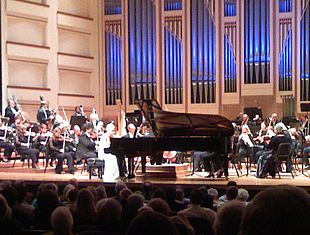
Back کنچێرتۆی پیانۆ CKB Klaverkoncert Danish Klavierkonzert German Pianokonĉerto Esperanto Concierto para teclado Spanish Klaverikontsert Estonian کنسرتو پیانو Persian Pianokonsertto Finnish Concerto pour piano French Zongoraverseny Hungarian
This article needs additional citations for verification. (January 2011) |

A piano concerto, a type of concerto, is a solo composition in the classical music genre which is composed for piano accompanied by an orchestra or other large ensemble. Piano concertos are typically virtuosic showpieces which require an advanced level of technique. Piano concertos are typically written out in music notation, including sheet music for the pianist (which is typically memorized for a more virtuosic performance), orchestral parts, and a full score for the conductor.
The standard practice in the Baroque and Classical eras (together spanning from circa 1600 to circa 1800), was for the orchestra to provide subordinate accompaniment over which the piano plays solo parts. However, at the end of the classical era, the orchestra had an equal role to the pianist and frequently had “dialogue” or “conversation” between the two. When music students and music competition auditionees play piano concertos, the orchestra part may be performed in an orchestral reduction, a conversion of the orchestra parts into a part for an accompanist playing piano or pipe organ, as it is very expensive to hire a full orchestra. Keyboard concerti were common in the time of Johann Sebastian Bach in the Baroque music era, during the Classical period and during the Romantic music era (1800–1910). Keyboard concertos are also written by contemporary classical music composers. Twentieth- and 21st-century piano concertos may include experimental or unusual performance techniques. In the 20th and 21st centuries, J. S. Bach's harpsichord concertos are sometimes played on piano. There are variant types of piano concertos, including double piano concertos, for two solo pianists and orchestra, and double or triple (or larger solo groups) concertos in which the piano soloist is joined by a violinist, cellist, or another instrumentalist.
© MMXXIII Rich X Search. We shall prevail. All rights reserved. Rich X Search